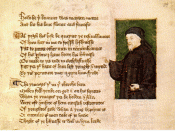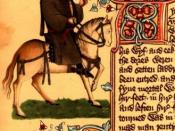In The Miller's Tale, we see the idea of courtly values being mocked. Courtly values are generally seen as the binding behaviour by which knights were meant to show courtesy, as understood in medieval times; act chivalrous, by showing courage, loyalty and mercy; and to uphold the idea of troth, by maintaining honour and integrity (Shea, Sep. 18). Unlike the preceding "Knight's Tale", "The Miller's Tale" values different attributes in it's characters. While the adherence to courtly values is usually what is hoped for in the gentility, and admired in the lower classes, we see that "The Miller's Tale" mocks those who obey traditional standards of behaviour. As we can see by the outcome of the events in the tale, "The Miller's Tale" prizes those characters who are shrewd, and who leave the ideals of the courtly values behind. This is made evident by the fact that Absolon is punished for his means of courting (that is, by traditional romantic standards), John is punished because his love for Alison is so great and noble that he allows himself to be fooled by Nicholas, and Nicholas is punished not because tries to abide by the behaviour of his time, but because he is foolish enough to try the same trick on Absolon twice.
Alison is the only one to escape retribution for her actions because she is consistently cunning and ignores the traditional standards of behaviour.
Absolon is portrayed as a farce of a courtly romancer. The manner in which he courts Alison is not very chivalrous. He is pictured as and effeminate "merry knave" (Chaucer 92) in his blazon, and plays music and sings in a high falsetto. As far as how he goes about winning Alison, he isn't very smart about the...


